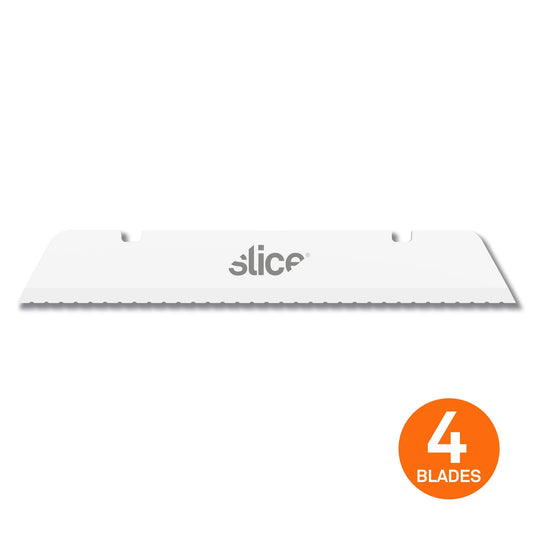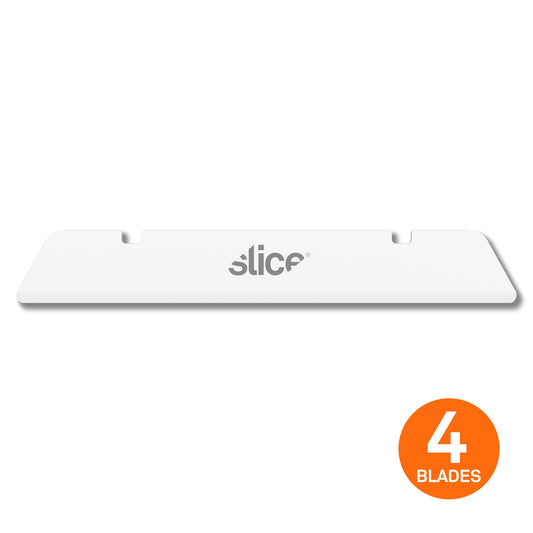Translation missing: hu.accessibility.faq_content_title
What Are Industrial Blades?
In a sense, all Slice® blades are industrial blades. That is, they are robust and designed specifically for use in industrial settings. Our 10538 and 10539 blades are called ‘industrial’ because they’re a response to customer demand for a longer blade, frequently used in industrial manufacturing. We worked with mattress companies and other manufacturers to develop a blade for soft, thick materials like mattress foam and insulation. In our 10559 and 10560 handles, the blades offer a 76-millimeter (or 2.99-inch) cutting depth. In our 10599 handle, the blades are used as scrapers.
While our blade edges are finger-friendly, they’re also effective when cutting or scraping, and last up to 11 times longer than dangerous metal blades. In addition, our safety blades are non-sparking, non-conductive, non-magnetic, chemically inert, and never rust, making them ideal for many industrial workplaces.
While our blade edges are finger-friendly, they’re also effective when cutting or scraping, and last up to 11 times longer than dangerous metal blades. In addition, our safety blades are non-sparking, non-conductive, non-magnetic, chemically inert, and never rust, making them ideal for many industrial workplaces.
What Slice Handles Use the 10538 and 10539 Blades?
Slice industrial knife blades are designed specifically for use in the 10559 and 10560 industrial knives, as well as the 10599 Long-Handled Scraper.
What Does Finger Friendly® Mean?
“Finger friendly” refers to the proprietary safety grind featured on our industrial knife blades, and all Slice blades. Our double-angle grind creates a shorter initial cutting zone and wider cutting angle. This technology takes into account the properties of skin, making lacerations much less likely than with traditional metal or ceramic blades. It’s a difference that has to be felt to be understood.
What Materials Can Slice Industrial Knife Blades Cut?
The 10538 and 10539 blades are designed for thick, soft materials, such as foam and insulation batts. They can also handle any application that requires more cutting depth than the Slice utility knives can offer.
Should I Choose Pointed- or Rounded-Tip Blades?
As with any safety knife design, the user has to balance safety with effectiveness. Rounded-tip industrial cutter blades are, of course, a better choice to protect against accidental punctures. Many people—used to traditional pointed tips—believe that rounded tips can’t be effective, but our research (and the information from our customers) tells us that rounded tips are effective for the majority of cuts. This is why we ship our handles with rounded tips: the safer option.
However, there are some materials that do need pointed tips to initiate a cut. In the case of our utility knives, we find that pointed tips are needed to cut plastic banding around pallets, for example. In a case like this, effectiveness takes precedence over safety.
However, there are some materials that do need pointed tips to initiate a cut. In the case of our utility knives, we find that pointed tips are needed to cut plastic banding around pallets, for example. In a case like this, effectiveness takes precedence over safety.
Will These Blades Chip?
All blades encounter small obstacles along their cutting paths, from specs of dirt to staples embedded in boxes. For softer metal blades, these distort the edge and eventually wear down the blade. Many advanced ceramic blades are also prone to chipping or breaking simply because they’re very thin or use a weaker composite material. Slice blades occasionally experience micro-chips along the edge. But because our blades have a wider cutting angle and we use 100 percent zirconium oxide (an extremely hard material), these chips are often literally microscopic and do not affect cutting performance. For this reason, even workers with heavy-duty applications can use Slice’s robust industrial blades with confidence.



